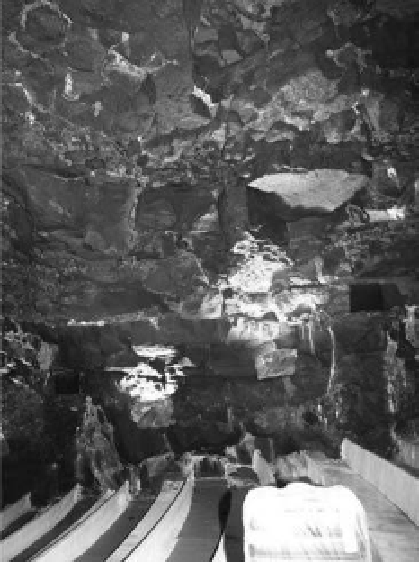Environmental Engineering Reference
In-Depth Information
mentioned. however, notwithstanding the physical
risk that these pose for people, they present the dan-
ger that they could make the general structural weak-
ness of the rocky medium previously studied spread
or deteriorate over time by creating larger openings.
This represents a second level of problems. it
was detected throughout practically the entire
auditorium and would affect blocks with a size of
approximately 50-60 cm.
in some cases the blocks have clearly open joints
which could indicate the strict equilibrium of these.
stability would be produced by possible bridges or
rock joint contacts with other adjacent blocks.
There is also the existence of another type of
blocks in which the joints are totally or partially
closed, however in which it is not possible to pre-
dict the real condition in interior areas where air
bubbles or fractured or weakened areas could
appear due essentially to the chaotic nature of the
formation of these kinds of volcanic masses.
Finally, there are blocks formed by the strata of
the different flows which are practically detached
from the solid mass by way of “platforms”. This
lack of unity could be the result of material loss in
the joints which surround them or of the presence
of smaller caverns thus producing an empty area.
Within this group there would also be platforms
the formation of which could originate from the
lava tube unit (lTU) which has produced a cover
similar to “onion skin” the thickness and quality
of which cannot be determined in depth.
in all of these cases, the hypothesis must be that
of fastening it using systems which allow securing
the blocks under consideration with regard to their
own weight. although there is always a certain
degree of friction between the planes, due to being
unable to determine the extent of this, as well as
the condition, it is recommendable to exert caution
and not consider its effect as beneficial.
as such, the hypothesis would be that of a block
with a volume of approximately 0.5 to 1 m
3
, to own
weight which would require a resistant force of
approximately 20 to 40 tonnes. a safety factor of 1.6
was applied and a specific weight of 25 kn/m
3
was
assumed, maximum value obtained in all the cases
tested in the MTU intermediate units and the roof.
one of the premises, which will be discussed
in more detail further on for this treatment, given
its extent throughout the cave, is to avoid as far as
possible, that these are visible once the action has
been finished.
3.4
Third-level problems isolated instability
by small-sized blocks
This type of problem, which could produce small
detachments, could arise practically anywhere in
the auditorium.
These blocks would be smaller in size, approxi-
mately 20 cm, i.e. 1 to 1.6 kn in weight employing
an increase of 1.6 as a pessimistic hypothesis. Given
the reduced size it would be difficult to apply iso-
lated stabilisation solutions using borings since the
area is too small to make a boring without causing
the block to become detached.
Based on these premises, the system studied
and ultimately used was directed at improving the
joint between various blocks thus improving each
of these individually. This could give the case of a
specific area suffering from a second-level problem
once all the smaller blocks have been joined.
3.5
Fourth-level problems superficial instability
These problems present the possibility that there
are erratic and random detachments, isolated
















